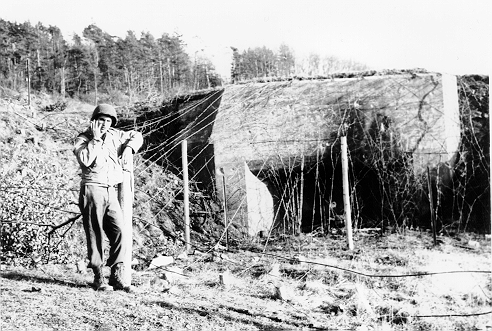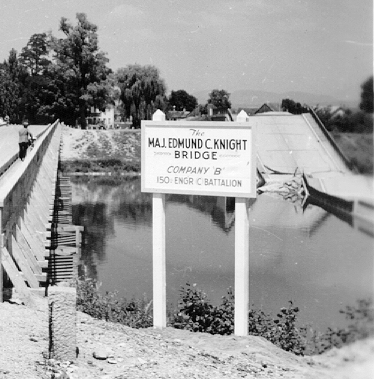The allied thrusts had earlier been blunted by the enemy's re-occupation of many of the Maginot Line forts, notably Forts Driant and Plappeville, near Metz on the Moselle River. The former, first attacked on 8 September 1944 was to hold out until 1545 8 December.1
On this 8 September Moselle River crossing effort at Dornot, France, the Battalion of Engineers of this narrative lost four men, two of whom were carried as M.I.A. and not changed to K.I.A. until their bodies were recovered in mid-December.
The efforts to by-pass and surround the Maginot line positions were nullified by the untimely gasoline crisis, which had been presaged on August 28 when the Third Army reported a 100,000 gallon shortfall in daily consumption.2
A month later, after forcing the Moselle South of Nancy, everything came to a dead halt. No gas in sight.
This same battalion of Engineers now of XII corps, spent the next six weeks in muddy, forested bivouac East of Nancy, along with most of Patton's Army. About the only actions were a few minor skirmishes to improve position but the Engineers were kept well occupied by the advent of seasonal rains. Roads built for horse drawn traffic were being torn to bits by what little was needed to sustain the defense. Bridges needed strengthening and the poor drainage from an excess of water resulted in great demand for crushed rock and logs for bivouac and outpost access. We were duly thankful that with our means of moving about we did not have to spend many nights in water-filled fox holes as did the outposts. Even so we were occasionally called on to fill a gap in the line.
In early November, with fuel stocks replenished the orders were to move out. It was the worst of times and over the worst of terrain- but move we must.
The attack was generally to the North along the Moselle-Saare
River basins, the shortest route into Festung, Europe. It was also
on the trace of the Maginot Line forward defenses with their
tanktraps and ditches, pre-positioned defensive and observation
posts and pre-planned flooding arrangements. These, the enemy
readily exploited. Even more vital however, was that at its
Northerly end, approaching Sarreguimines, it was within
observation, and long range artillery of the most concentrated
strength of the
Siegfried Line forts.3
of the
Siegfried Line forts.3
That wasn't all. The heavens opened up with rain for the month more than doubling the norm.4 The dish shaped area laced with shallow feeders and low-gradient main streams restricted movement and manuever to those sectors which the Germans knew and elected. Late morning mists and early afternoon fog prevented air support and effective observation.
The advance became the dreaded ploddingly muddy-boot after muddy-foot, wet all the time, movement.
One Division, the 26th, reported in that bleak November advance 661 killed, 2154 wounded, 613 missing with non-battle casualties from exposure trench foot and fatigue a near equal number of 2898 officers and men- approximately 45 percent of the total with 25% largely due to weather.4
The full impact of that winter later reported to be the worst in 40 years was later to be experienced in another section of the Siegfried, near Luxembourg.
There were observations of entire tank units, up to battalion size mired in forest bivouac, the troops occupied in cutting down tree to aid exit trackability.
One memorable sight was of a tank destroyer troop of about eight thin skinned vehicles that was caught on a one-way road, side ditches flooded. The German Oerlicker piece in the nearby village took out the lead vehicle- next the last. There was no place for the rest to go so they were 1eisurely knocked out while the crews hugged the water's edge and watched. No way to win a war.
Thus only the armored infantry and they suffered heavy losses, could be deployed to help the afoot infantrymen.
Our role on that not so momentous drive in addition to building bridges, was clearing mine fields, filling craters, removal of road blocks of farm implements or felled treest opening debris blocked village streets and occasionally defending a vital bridge or destroying one to protect a flank.
As we gradually worked our way up the Sarre with much localized bridging as well as on the main stream, we became more exposed to the Siegfried Line fortifications, which no amount of air cover, even if the weather permitted, could have dented.
The action in and around Sarreguimines, whose Northerly tip is on the German side, is particularly memorable. The Line from there followed a tributary, the Bleis River, then in flood, generally parallel to the Sarre on an extension Eastward. Thus a long stretch of the Sarre was exposed to these fires.
The village of Sarreinsming, several miles south of Sarreguimines and on an approach to the Siegfried that could allow enveloping that crucial city, became a focal point one unforgettable night.
Our orders were to get tanks across the river somewhere in the vicinity of the city. Typical of most of Europe and long used, the two best sites were at the village of Remelfing, bank configuration favored a ferry and at Sarreineming, where a destroyed bridge had allowed hand-over-hand passage of a few troops who occupied the far side portion of the village.
The bridge was a semi-permant replacement of a more permanent stone structure which we learned had been destroyed in the German Blitzkrieg conquest of France In 1940. The approximately 150 foot gap had some undamaged piles near its center that could serve as intermediate support for the 160 determined need, just within, the limit of a double paneled, on each side, Bailey type bridge.
The decision was to start a diversionary raft constructed at Remelfing, two miles downstream and the main effort at Sarreineming. The late fog and the next day early morning mists promised an 18 hour period of obscurity though as we were soon to discover, the sites had long before been zeroed in by the long range Siegfried artillery.
Unlike most European villages that hugged the rivers, the houses were not clustered on the banks because of the broad flood plain. Thus the main channel and its bridge were a 100 yards or so from the protective cover of the stone houses on both the far as well as the near side. There was an intervening concrete walled canal, part of the Sarre navigation system.
The action started with laying 24 feet of steel treadway across the canal, then tearing out the remaining remnants of the destroyed bridge and bringing the intact piers up to proper level. This was met with only periodic artillery fires from afar, not exactly on target.
But things quickly changed with more direct and disruptive fire from much closer, with work crews being forced to withdraw to the cover of the village structures. Each time work was resumed the same direct fire was laid onto them forcing another withdrawal.
Periodically the long range stuff from the Siegfried added to the cacophony and even an occasional sniper tuned in.
Our artillery observer was called in, spotted an approximate range and direction and laid on fire for affect. It repeatedly became an artillery chess match with the Engineers, as the pawn, trying to put in the bridge.
It became increasingly difficult to separate the troops from their cover to continue the work.
It took a while, too for the bridge commander to realize that some one had to be very close to the operation for the direct fire to come in at such opportune timing. Though offering small consolations they were later to be found to be two tanks, well dug-in and thus immune to our artillery.
Having so deduced, after too long a time, the Regimental Commander of the far side troops was requested to screen the area, put all people in a central location under security. He did so, using the local church for their sequestration.
After that, about three A.M. the opposing artillery became less effective, at least in regard to timing and the bridge progressed.
A few hours later as it was coming to completions largely by feel, the emergency of light revealed a disturbing complication. Those sharp-shooting artillerymen on the far side had severed the upper chords of one of the side by side panels.5
There was no way it could take a tank. What to do?
After some head scratching it was decided to file off the jagged edges, add panels above the break and at the two adjacent sections. The tanks got across, though barely.
It was a weird, unbalance structure hardly what one would expect of a bridge. It was certainly not one that Michaelangelo would have admired but the more pragmatic Leonardo da Vinci may have because of its utility.
Things had fared little better at the Remelfing ferry site. In addition to Seigfried fires, it was handicapped by the swift flowing, flooding Sarre and ill-defined, changing banks.
As it was coming to completion the site-commander took a
coffee-can sized chard of Siegfried steel in his side. He was honored with a post-humous Silver Star and a main
thoroughfare at Fort Belvoir carries his name.*
He was honored with a post-humous Silver Star and a main
thoroughfare at Fort Belvoir carries his name.*
After the tanks started rolling across the Sarreinsming bridge a casual walk around the far abutment brought a shock. Here was an obviously recently occupied and well used fox-hole. After all these lessons of being damn sure that the far-side of such an operation is well secured, the bridge commander had made a false assumption and a damning miscue. It could be argued that the logical thought process had been dulled by being too emotionally involved in the action. So there was an amplified lesson, with several later occasions for its use- Don't get too closely involved. Stay far enough back to keep the total picture in perspective. It might lead to a longer life, too.
During the campaign the Battalion put in a total of 22 bridges varying from 30 to 300 feet, mainly steel panel type and totaling 1432 feet. Few were without opposition.
Notable among these was an 110 foot triple-double Bailey (Three panels side-by-side, two high. Each side of the roadway) was double the usual 30 ton capacity for Sherman tanks and was intended to accommodate some tank-mounted flails and 155 mm self propelled rifles to aid in overcoming the heavy Siegfried concrete forts.6
Unfortunately, it and most of the others had to be destroyed when Third Army was diverted to a higher calling on December 22. It was to repel the Hitler Gotteramerdung, later to be known as the Battle of the Bulge. Thus the Germans returned and the Sarreguimines area became No Man's Land with no immediate needs for bridges.
All our blood and sweat appears to have been in vain- but was it?
Oh, Well, Such is War.
1 The Lorraine Campaign, Hist. Div., Dept of the Army, Page 449
2 Ibed. Page 24
3 The Lorraine Campaign. Hist. Div, Dept of the Army, 1950 Page 322
4 With a norm of 2.4 to 3.0 inches for each of Sept. Oct & Nov. the total for Nov. 44 was 6.97. Page 29 of The Lorraine Campaign
5 150th Engineer Battalion History, 1945, page 25
*Major Edmund C. Knight
6 At the East Abutment of this bridge's permanent replacement is a beautifully greened park dedicated to a U.S. Major of Civil Affairs who succored the people after they were forced to return to their cellars and the caverns that dot the Sarre banks.